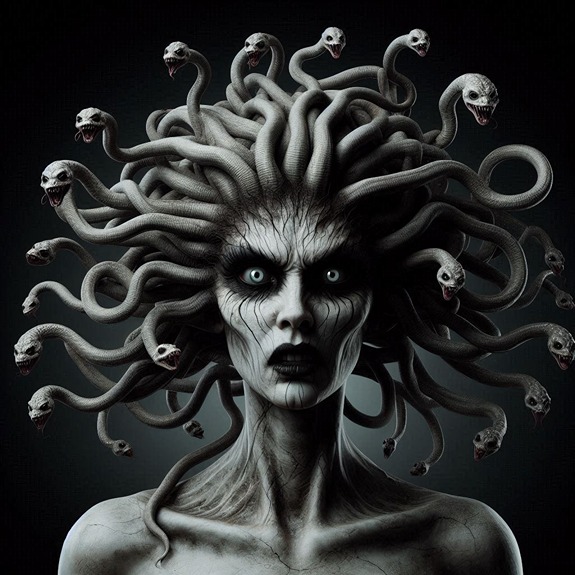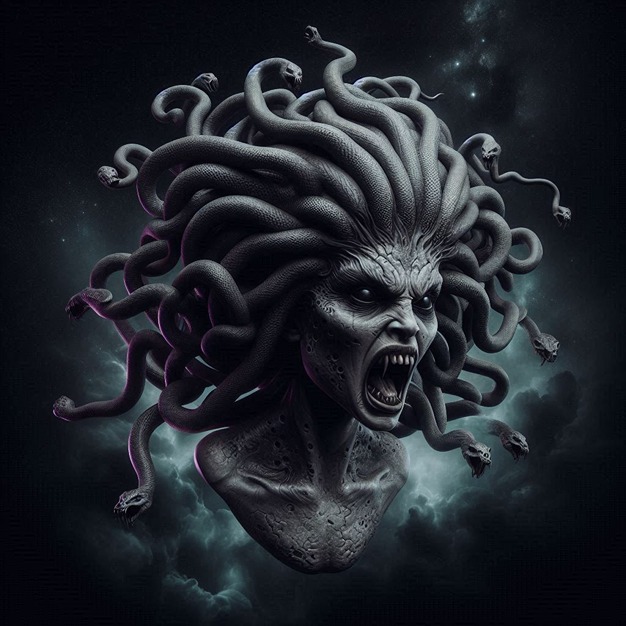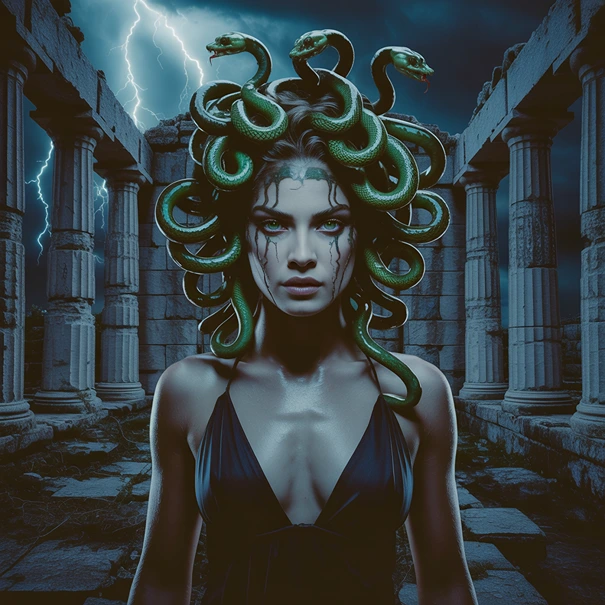The Monstrous Story Of Medusa: From Greek Mythology, Through Feminism, To Horror Movies
It happened to me during my recent vacation in the fantastic city of Athens. While my wife was browsing through the shops and stalls looking for gifts for herself, work colleagues, family, and friends, I trailed behind her, occasionally making constructive comments (basically, “That looks cool” about every item she showed me), carrying the bags, and pulling my credit card out of my wallet. Shopping doesn’t appeal to me much, mainly when it doesn’t involve products related to my favorite world of horror. What saved the day for me was that I repeatedly encountered a mysterious and frightening figure on the ancient marble-paved streets of Athens, among magnificent statues and historical relics. It was a woman with snakes in her hair, a face twisted in rage, and some message, primarily about femininity.
“Hey, look, it’s Medusa! Let’s buy this!” I announced to my wife, my eyes sparkling every time I saw a product with the mythical Medusa on it. “What’s her story?” she asked as I handed her my credit card and received a few more bags to carry in return. “Look, it’s a very complex story, which is relevant today from a feminist perspective. This horror myth involves rape, a curse, beheading, offspring that grow from the neck like they were in the Greek version of the movie “The Thing,” and a woman with snakes in her hair that will turn you to stone,” I muttered what I knew about Medusa. Judging by my wife’s look, I was in big trouble. “But the bottom line is that it’s one of the symbols of Greece, and also a symbol that says something relevant about current culture. So, Maybe we should get some Medusa for our home?” I asked gently.
One look into my wife’s angry eyes and hair, which suddenly started to go wild like an angry snake (metaphorically, yes?), and I turned to stone (again, metaphorically). The last thing I remember was flying through the air and landing on the Acropolis.

Who Is Medusa?
The Medusa Greek mythology story seems like something out of a ruthless horror movie, so we will start with some fascinating facts about Medusa. In general, Medusa (from a Greek word meaning “protector” or “guardian”) is a monstrous female figure who has undergone several gruesome transformations. Today, we know her as one of the three “Gorgon” sisters (or “Gorgo”) in Greek mythology – that is, mythological monsters characterized by hands made of metal, extremely sharp fangs, mesmerizing blue eyes, and hair made of living, venomous snakes. While Medusa’s sisters, Stheno (“forceful”) and Euryale (“far-roaming”), were immortal, Medusa was mortal and indeed not a monster. This detail is vital for the rest of the story.
Before Medusa’s hair contained snakes, she was beautiful, with golden curls and blue eyes. This sight pleased Poseidon, the god of the sea. Whether or not the young Medusa seduced him – and to this day, there are countless criticisms of the connection between “seduction” and “rape” in which the story is sometimes presented, which places a certain amount of blame on the victim – the fact is that, according to mythology, Poseidon brutally raped Medusa, or at least slept with her. We are talking about a mythological story with several versions.

In any case, Poseidon chose to do this in none other than the temple of Athena, the goddess associated with wisdom, warfare, and handicraft. Athena, who had a bitter rivalry with Poseidon (especially since the inhabitants of Athens considered her the patron goddess of the city), was furious at the defilement that occurred in her temple, which mainly stemmed from the blood that fell from the genitals of Medusa, who had until then been a virgin.
Athena decided to punish Medusa and curse her in a way that may seem strange or even scandalous today. From a beautiful girl, Medusa turned into a Gorgon, a monster with a distorted face, a long tongue protruding from sharp fangs, venomous snakes writhing furiously as hair, and eyes burning with red fire, making anyone who looked at them turn into stone. Athena banished Medusa in disgrace to a distant region outside the Hyperborean lands with their eternal sunlight.
💀 Killer Deals & Scary Recommendations 💀
🎭 Costumes & Accessories
HalloweenCostumes Fun Costumes Entertainment Earth
🛒 Online Shopping
AliExpress Amazon Walmart Etsy
🧛 Collectibles & Horror Brands
Funko Hot Topic Lego Spirit Halloween
🎢 Attractions & Tours
GetYourGuide Tiqets Viator Klook
📖 Blogs & Horror Sites
Bloody Disgusting iHorror Fangoria
🩸 Disclaimer: Some links are affiliate links. The price stays the same – it just helps keep the site alive 👻
Who Killed Medusa? And Why?
Unfortunately, Medusa’s story does not end there. At some point, King Polydectes of Seriphos ordered the hero Perseus (son of Zeus) to kill Medusa, or worse, to behead her and bring it to the king. Athena and the messenger of the gods Hermes took part in the elimination mission, among other things, by providing him with a sickle, a shield with a mirror on the inside (so that he could approach Medusa without looking directly at her), and winged sandals.
Perseus managed to approach Medusa and behead her. Horrifyingly, from Medusa’s severed neck sprang her unwanted seeds from Poseidon, who later became the winged horse Pegasus and the giant Chrysaor. Some versions claim that the offspring did not come from the neck but from mixing earth and blood.

What Did Medusa Look Like?
You will also find different versions regarding Medusa’s specific appearance or the three Gorgons’ appearance in general. In Apollodorus’s collection of myths and legends from the second century AD, for example, Gorgons have dragon scales, boar tusks, and golden wings, which they used to fly. In archaic Greek decoration and ornamentation (from the eighth to the fifth centuries BC), Medusa was usually depicted in a cartoon style, with large, wide eyes, an open mouth, and a protruding tongue and fangs. Medusa’s head was described as disproportionately large and round for a long time.
From the Hellenistic period, artists began reimagining Medusa as a less monstrous figure but a pretty woman with a few minor “flaws,” such as strange eyes or snake-shaped hair. The grotesque image of Medusa became less common, and many of the representations in visual art or the consumer world today are based on this idea.
When A Severed Head Serves The Hero
Later, as part of Perseus’ heroic journey, he used Medusa’s severed head to rescue the mythical princess Andromeda, the daughter of the Ethiopian kings Cepheus and Cassiopeia. According to the story, which this time seems to have come out of a Hollywood action epic, Andromeda was punished for the arrogance of her mother, Queen Cassiopeia, who bragged that her daughter was more beautiful than Poseidon’s children, or, according to some versions, than Athena herself. An angry Poseidon flooded the shores of Ethiopia (as the northern coast of Africa was called) and sent a monster to work its plot against humans. The kings were advised that only if they allowed the beast to devour their daughter they could they get rid of it and save the people. The king chained his daughter to a rock on the beach – perfect parenting whatsoever – And waited for the monster to get what it wanted.
Then, Hero Perseus randomly walked by. He saw Andromeda, fell in love with her, and promised that if he married her, he would kill the monster. In the end, he kept his promise. Riding Pegasus, he used Medusa’s severed head to turn the monster to stone. Andromeda, who somehow accepted with equanimity that her future husband was walking around with severed heads, broke free, married him, and bore him nine children. It is a romantic ending, to say the least, to a gruesome horror story.
Perseus gave Medusa’s severed head to Athena, who marked it in a breastplate, creating another strange distortion of those who use the power of the victim they killed to provide themselves with protection. Mythology has it that Medusa’s head was hidden in an ancient Roman temple in Corsica.

The Clear Connection Between Medusa And Feminism
Like many women throughout history, Medusa was transformed from a victim to a culprit, punished for an act she did not choose (according to the sexual coercion version), or at least did, but was punished severely and disproportionately compared to a man. But why is Medusa a symbol for sexual assault survivors?
From a modern feminist perspective, some women argue that the story echoes the way patriarchal society treats victims of sexual violence to this day. According to this view, Medusa, who a man raped, was ultimately punished by a woman. Her transformation into a monster, according to some analyses, simulates the process of impurity that many women who are sexually assaulted experience, with feelings of being “unclean” or destroyed, shame, rage, or even internal guilt.
According to another recent feminist analysis, the curse of Medusa may represent the social isolation that various women who have been sexually assaulted experience. We can interpret their hazardous gaze as a metaphor for how women who have been traumatized by this type of trauma become “dangerous” in the eyes of society, which avoids them, fears them or tries to distance them rather than helping them cope with their pain and trauma.
Medusa As A Symbol
On the other hand, some see the figure of Medusa as a clear empowerment, for example, in terms of her gaze that turns onlookers to stone – which may symbolize the power women have to stop attackers, protect themselves, and become “fighters.” Various feminist women and art have adopted Medusa as a symbol of resistance and female power, or even a female power that threatens the patriarchal order.
Various women, and to a large extent those who have experienced sexual violence, use Medusa as their symbol. Some victims choose to get a Medusa Tattoo on their bodies out of identification with the mythological story. Medusa Tattoo’s meaning can also symbolize a traumatic event they have gone through that they do not want people to ignore.
Over the years, Medusa has become a symbol, some would say, an icon: a figure that, even if you don’t understand her historical, mythological, and contemporary meanings, you can still encounter her.

The Influence Of Medusa On Greek Culture
The attitude of Greek mythology to the myth of Medusa is undoubtedly complex. On the one hand, we can claim that the character represents the male fear of the unknown and uncontrolled female power, the fear of the strong and “untamed” hermaphrodite, which supposedly threatens the social order. We must not forget that Perseus, perhaps one of the most prominent representations of a male hero, is the one who defeats Medusa in the end. He even uses her in another heroic act: rescuing a “helpless” princess.
On the other side of the picture, some see Medusa as a symbol of protection in ancient Greek culture. In ancient times, people would embed her head in various places inside and outside the home or even bodies, whether doors, walls, breastplates, shields, statues, etc. The goal was to keep evil away from the living environment.
Of course, today, we see the figure of Medusa as part of a broad consumer world intended (mainly) for tourists, with a wide variety of souvenirs and gifts you will find in every corner of the Greek capital.
Sicily Medusa Symbol
The flag of Sicily, the romantic Italian island, features a triskelion (from the Greek for “three-legged”) – a symbol made up of three bent human legs, which can also be three spirals intertwined, or any other symbol made up of three parts with rotational symmetry. In the case of Sicily, that triskelion includes three legs that symbolize the three sides of the island.
What interests us more is that the creature’s face, according to the traditional symbol, includes the head of Medusa or the mask of a Gorgon. According to reports, the Sicilians wanted to incorporate Medusa into their symbol to protect them from the evil eye. In early versions of the flag, the face of Medusa was frightening. Still, in 1947, the Sicilian parliament decided to comply with requests and redesigned the flag with a much softer and more feminine face.

Before you raise an eyebrow, we should mention that the connection between Medusa and Sicily, or more precisely – Greek mythology and the Italian island – is closer than you think. There are quite a few mythological stories that took place in Sicily, for example, the heroic fight of Hercules against a cruel king, the abduction of the spring nymph Persephone by the god of the underworld and fire, the pursuit of Odysseus by the Cyclops, and more.
Medusa Fashion House Versace
In the fashion world, the most famous representation of the mythical Medusa is the logo of the Italian high-end fashion house Versace, which proudly bears the image of Medusa’s head.
According to the stories, the Versace brothers came across the symbol on the floor of a ruined building in the city where they grew up, Reggio Calabria. The figure left an impression on them, and at some point, Gianni Versace chose it as the logo of the fashion house he founded. He hoped that just as Medusa made people fall in love with her without any way out, his company would have a similar effect on people. The young founder hoped his company would have the same impact on people as those wearing his clothes and shoes.

The Medusa on the Versace logo is supposed to express the brand’s design philosophy, which celebrates boldness, seduction, and the interplay between beauty and danger, believing that the logo will always remind people of the brand’s need to push the boundaries of fashion and challenge traditional norms.
Medusa Hits Other Areas
In the jewelry world, Medusa has become a very popular symbol in women’s jewelry, especially among young women. Since ancient times, you can see pendants, rings, earrings, and other bracelets on which Medusa’s figure has been adorned, sometimes as a clear feminist statement.
In the world of art, you can find impressive sculptures, some of which try to offer a new meaning to the story – for example, a statue by an artist that shows Medusa holding the severed head of Perseus, and not the other way around. In cosmetics, to take another example, Medusa appears on various packaging and products, including those that try to empower women, enhance their self-confidence, and express uniqueness.
Today, as mentioned, you can find Medusa on a very long list of decorative items, gifts, and souvenirs sold on every corner of Athens and in online stores, such as:
![]() Medusa fashion items, like shirts, hats, socks, and more
Medusa fashion items, like shirts, hats, socks, and more
![]() Medusa Costumes, including scary costumes
Medusa Costumes, including scary costumes
![]() Collectibles, like Medusa Funko Pops, Statues, and Action Figures
Collectibles, like Medusa Funko Pops, Statues, and Action Figures
![]() Medusa LEGO sets, figures, and minifigures
Medusa LEGO sets, figures, and minifigures
![]() Medusa Dolls
Medusa Dolls
The Best Movies About Medusa
Medusa has appeared in works of art and cultural texts since ancient times and has been honored time and time again. Medusa’s name has been given to, among other things, a French ship (which sank off the coast of Senegal in the 19th century, but don’t spoil it), countless scientific discoveries (for example, an asteroid discovered in 1875), characters in computer games, and more.
There have been movies about Medusa: Most of them are epic action tales from Greek mythology, in some cases with some modern twist. In addition, you can even find some horror films about Medusa, as we will discuss soon.
The Gorgone’s Head (1925)
Medusa, or sometimes Gorgones, has appeared in various cultural texts. One of the earliest works is the short silent film “The Gorgone’s Head.” The film is about 16 minutes long, and surprisingly enough, I could not find a director’s credit for it on IMDB. It presents the mythological story of Perseus, emphasizing his quest for the head of Medusa and the adventures he went through on the way there. It’s hard to say that this film is a classic – in fact, I couldn’t even find a rating for the movie on IMDB – but it did refer to Medusa and her mythological story about 100 years ago.
Medusa Against the Son of Hercules (1963)
Moving on a few decades, to an Italian-Spanish production known as “Medusa Against the Son of Hercules” (or originally in Spanish: “Perseo l’invincibile“). This is a film from the “Swords and Sandals” genre, films that flourished in the 1950s and 1960s in Italy and presented stories based mainly on mythology, history, or fantasy, which took place in locations such as Rome or ancient Greece. The films were packed with action and drama but mainly had a low budget, a kind of “B movie” that was successful until the rise of spaghetti westerns.
In “Medusa Against the Son of Hercules” Medusa is depicted as a wandering creature with one glowing eye. What is interesting, in our context, is that the person who created the Medusa here was the special effects and makeup effects Carlo Rambaldi, who later brought to life iconic creatures such as the Xenomorph from the “Alien” franchise and the home-sick alien from “E.T. the Extra-Terrestrial.”
The Gorgon (1964)
In “The Seven Faces of Dr. Law” from 1964, the witty fantasy Western in which the brilliant Tony Randall played seven different characters, one of which was Medusa. That same year, the horror production company Hammer – known for excellent, low-budget horror films – released “The Gorgon.”
The plot of ‘The Gorgon” takes place in Europe in the early 20th century, when a beautiful gorgon who takes on human form terrorizes a small European village by, you guessed it, turning the inhabitants into stone. Terence Fisher, responsible for dozens of horror films for Hammer from the mythologies of Dracula, Frankenstein, Werewolf, and others, directed the film.
The cast included many of Hammer’s horror actors, like the legendary Christopher Lee (“Dracula,” “The Wicker Man” and also the “Lord of the Rings” and “Star Wars” films), Peter Cushing (who played Victor Frankenstein and Dr. Van Helsing in his prosperous career and also appeared in classic movies such as “The Abominable Snowman” and the original “The Mummy”), Barbara Shelley (“Dracula: Prince of Darkness,” “Village of the Damned”) and many others.
Clash Of The Titans (1981, 2010)
You can’t talk about mythological characters and miss “Clash of the Titans,” the 1981 action and fantasy film by Desmond Davis starring Harry Hamlin, Burgess Meredith, Maggie Smith, and Laurence Olivier. The film is based on Greek mythology and features famous characters, from gods such as Zeus and God of the Dead Hades, through the hero Perseus, to terrifying creatures like Andromeda, Pegasus, and Medusa.
The character of Medusa here is created using stop-motion animation and is different from her conventional representations, both ancient and modern. Its lower body was that of a snake and not legs, or the fact that, in addition to her petrified gaze and snake-like hair, she used a bow and arrow with a devastating poison at the end.
In 2010, Warner Bros. released a more bombastic remake of “Clash of the Titans” in 3D. With a budget of about $125 million, the film grossed almost half a billion worldwide despite lukewarm reviews. It featured an explosive cast that included Sam Worthington, Liam Neeson, Ralph Fiennes, Gemma Arterton, Nicholas Hoult, Kaya Scodelario, and the model And the Russian philanthropist Natalie Vodianova, who played Medusa here, in a slightly more faithful representation of the original: a human and beautiful face, which contorts frighteningly as she turns her unfortunate victims to stone.
Monsters, Inc. (2002)
We have already written on the site about our love for “Monsters, Inc.” a charming animated film that can be one of your children’s gentle and enjoyable introductions to the world of horror. One of the most likable characters in the movie is Celia, who works as a secretary at Monsters, Inc. – which, as you may recall, collects screams and converts them into energy. She is also the girlfriend of Mike, the little green monster with one eye.
Celia is a lovable purple monster with snakes in her hair, which come to life when she concentrates: an apparent reference to the character of Medusa. It is important to note that, unlike in Greek myth, these snakes do not cause the character to freeze, although there is a scene that does humorously refer to this effect. Another fact that is particularly relevant to us is that in the original English version, the person who played Celia is horror icon Jennifer Tilly, aka Tiffany, Chucky’s doll lover from the “Child’s Play” films.
Percy Jackson Fighting The Medusa
The fact that Medusa appears in the Percy Jackson series should not surprise you because the “Percy Jackson” book series “The Olympians” – which has since spawned two not-so-bad films – brings Greek mythology to the present day, with a character of a demigod (the son of Poseidon, by the way. Yes, the one who supposedly raped Medusa) who sets out with some friends on a journey to prevent a war between the mythical gods.
In the first book (and film) in the series, “Percy Jackson and the Olympians,” the guys encounter mythological figures and monsters, including Medusa, on their way to the underworld and Olympus (which lies on the 600th floor of the Empire State Building in New York). In the film, the cinematic goddess Uma Thurman plays Medusa. In the story, Medusa wears sunglasses to hide her petrified eyes and a cloth in her hair to hide the snakes. Annabeth, played by horror darling Alexandra Daddario (a woman whose stunning blue eyes can be just as paralyzing as Medusa’s), covers her eyes and stays alive. Percy and his friend Grover also use their cell phone camera to avoid direct gaze.
In a manner that corresponds to the mythological story, Percy cuts off Medusa’s head so that they can use it if necessary in their fight against the next monsters. This fight comes quickly, and the hero uses the head to turn a fire-breathing monster with several heads – which may be a mythological creature I didn’t recognize – to stone.
Miss Peregrine’s Home for Peculiar Children (2016)
“Miss Peregrine’s Home for Peculiar Children” is a lovable fantasy film by Tim Burton from 2016, based on the book of the same name. Two of these “Peculiar Children” who appear in the plot are the very creepy twins dressed in scary costumes that look a bit like makeup. We do not know much about these twins and their powers, except perhaps that, like Medusa, they can turn people to stone. They wear masks with holes in their eyes (in the book) and are characterized by pale and “Scabby” gray skin, with gray snake eyes and fangs.
The Stoners Of Wednesday
Continuing with Netflix’s hit series “Wednesday,” which brought the Addams Family franchise back to life, alongside the main characters, led by Wednesday Addams (Jenna Ortega), we encounter Nevermore Academy, a boarding school for special and outcast people with strange powers.
One of the four main cliques in the boarding school – along with the “fangs” (vampires), the “scales” (sirens), and the “furs” (werewolves) – is “The Stoners,” which in this case are gorgons. This group of male students turns others to stone when their snakes are exposed. In one scene from the first season, a gorgon boy accidentally looks at his reflection while washing his snakes in the shower and is temporarily turned to stone.
V/H/S 99 (2022)
We end the review with the anthology series “V/H/S,” which consists of short stories in the found footage style – some of which have already exposed us to mythological characters, such as a Succubus. The fifth film in the franchise, “V/H/S 99,” from 2022, consists of five short horror stories that take place in, you guessed it, 1999.
What interests us is the fourth story, “The Gawkers,” in which we follow a teenage boy who makes stop-motion films of toy soldiers. At one point, his older brother steals his camera. He uses it for endearing romantic purposes, such as taking pictures under women’s panties or secretly filming Sandra (the sweet Emily Sweet from “Fear PHarm” and the disappointing reboot of “Castle Freak”), the hot blonde who has moved in next door. The guys hope to hack into her webcam to watch her in intimate moments, especially when she undresses, but it comes at a price. Without spoilers, you’ve probably already figured out what they’ll see in her hair. Without spoilers, let’s say that Sandra will discover that someone is watching her and that some of the characters will end up turned to stone.
You can find the character of Medusa in a wide variety of anime and comic books, such as “Wonder Woman” (Diana Prince fighting Medusa) or the TV series based on DC’s cinematic universe. We’ve seen Medusa or at least Gorgon characters in series based on encounters with supernatural creatures, such as “Charmed: The Next Generation” or “Chilling Adventures of Sabrina.“ In the world of video games, she’s appeared in games like “Dungeons & Dragons,” “Final Fantasy,” “Assassin’s Creed Odyssey,“ a skin in “Fortnite,“ and many more.
The good news is that you’ve learned much about Medusa from Greek mythology, one of the most disturbing, violent, and controversial ancient stories. The bad news is that the next time you visit Athens and your wife asks you who this Medusa is that interests you so much, you might want to push aside this cruel mythological story. Sometimes, a beautiful woman with snakes in her hair and murderous eyes is the lesser of two evils.





